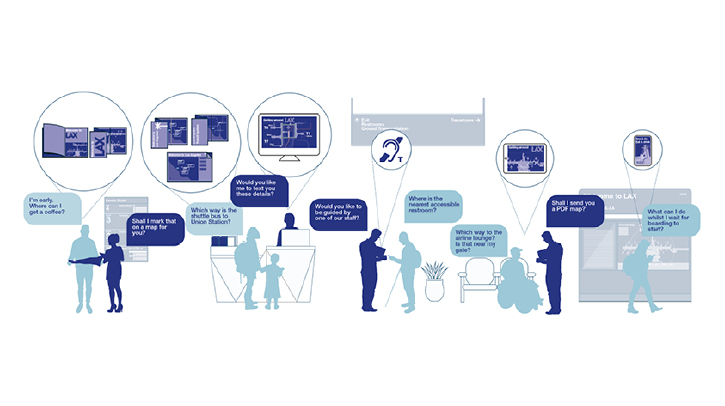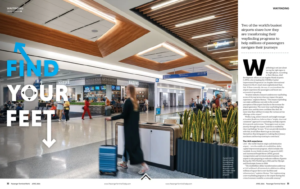 Passenger Terminal Today speaks to Terri Mestas, about her previous role as chief development officer at Los Angeles World Airports (LAWA), to find out more about the recent wayfinding overhaul at Los Angeles International Airport, as well as the key challenges it faced and the science behind effective wayfinding.
Passenger Terminal Today speaks to Terri Mestas, about her previous role as chief development officer at Los Angeles World Airports (LAWA), to find out more about the recent wayfinding overhaul at Los Angeles International Airport, as well as the key challenges it faced and the science behind effective wayfinding.
Why did LAX need to overhaul its wayfinding system? What were some of the key problems the airport faced in terms of wayfinding?
LAX is the world’s busiest origin and destination airport in the world, and in 2022, ranked as the sixth busiest airport by passenger volume globally. Currently underway, LAWA’s multibillion-dollar Capital Improvement Program includes the Landside Access Modernization Program (LAMP), the automated people mover (APM), ground transportation facilities and terminal modernizations, which all contribute to “a transformation like no other” at LAX.
The airport’s current wayfinding system was implemented incrementally over a long period, creating an opportunity to now create a cohesive and uniform strategy to guide guests consistently. The new system will organize guests’ movements throughout newly interconnected terminals, the upcoming APM train system, the Consolidated Rent-A-Car (ConRAC) facility and other amenities at LAX. A holistic and clear wayfinding system is needed to link these offerings together while reducing traffic congestion in the Central Terminal Area (CTA) and improving the overall guest experience.
“Wayfinding can make a difference not only to the overall perception of the airport but the revenue the airport generates”
Aviation industry research underscores wayfinding as one of the top factors that impact the guest experience. This means wayfinding can make a difference not only to the overall perception of the airport but the revenue the airport generates. The more time wayfinding helps guests save and the more confident they feel, the more time they will have to enjoy the various service offerings at the airport, including restaurants, lounges, duty-free shops and premium amenities.
Based on studies and stakeholder interviews, the number one question we get from passengers at LAX is, ‘Where can I find this airline?’. With multiple ways to access the airport, the new wayfinding program will create info hubs that equip guests with the information they need to know, including where they are, where they are going and what to expect next in their journey.
As the City of Los Angeles prepares to welcome the world for the FIFA World Cup in 2026 and the Olympic and Paralympic Games in 2028, millions of guests will arrive and depart through LAX, which will provide their first and last impression of the city. Over the next few years, LAX will focus on implementing our world-class Capital Improvement Program to support a gold-standard guest experience. A comprehensive, intuitive and clear wayfinding program is critical to achieving this.
How did the team find the right new approach? Were passenger behaviors analyzed, for example?
To streamline the wayfinding experience at LAX, LAWA undertook a comprehensive assessment of the wayfinding system in 2018 and developed a new wayfinding strategy along with updated signage and wayfinding standards. The standards represent a living document informed by ongoing development projects to expand the range of wayfinding products and services that will help meet user needs across all environments and journey stages. The implementation of the wayfinding system will also provide opportunities to evaluate, refine where necessary and evolve solutions in response to feedback from day-to-day service and operations.
During numerous studies, LAWA conducted a wayfinding assessment that evaluated the journeys of departing, arriving and connecting passengers to understand the ‘what, where, why and how’ elements of wayfinding that apply to new LAX facilities, such as the new APM train system. The findings of the studies were incorporated into our Signage Standards and Design and Construction Handbook. These guiding documents ensure uniformity and a consistent wayfinding vocabulary across all projects.
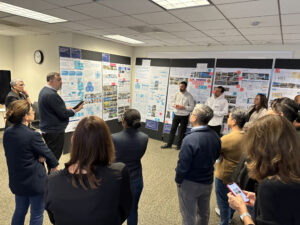
Our studies involved internal groups across the airport and external partners and stakeholders. Engagement with internal and external teams will continue throughout the project and soon, we will select a progressive design-builder through a competitive RFP process to develop an airport-wide implementation plan to deliver the work.
What were some of the key challenges faced when deploying the new wayfinding system, and how were these overcome?
Since the new wayfinding and information system will be realized across the entire airport campus, manifesting as physical, digital and human-to-human interactions, the phasing of how the work will be rolled out is the most complex component of the project. This is especially true because LAX operates 24/7 with minimal ‘non-peak’ hours. We are also looking for opportunities to create futureproof strategies that can be adapted to meet new technology, customer experience and partner needs. Finally, educating our staff and partners – about 50,000 individuals – on the strategies we are employing so they are comfortable and confident ambassadors of the work is also a challenge we are preparing for.
What is the science supporting effective wayfinding within an airport?
The science behind effective wayfinding in airports combines insights from a range of design and human sciences. Wayfinding is anchored in environmental and cognitive psychology, architectural theory and practice, semiotics and ergonomics, human-factors engineering and user-centered experience design. The overall goal is to create legible environments. Legible places are easy to comprehend and use – even in complex environments like airports.
“Wayfinding is anchored in environmental and cognitive psychology, architectural theory and practice, semiotics and ergonomics, human-factors engineering and user-centered experience design.”
A key concept in environmental psychology is spatial cognition. This determines how people perceive their environment and comprehend spatial information as mental maps. Spatial cognition acts as an internal resource, informing how people plan, orientate, navigate and make decisions. Understanding how individuals perceive and mentally represent spatial information is crucial for designing effective wayfinding systems. Another key concept is cognitive load. Airport environments can be overwhelming for people, and excessive cognitive loads can hinder wayfinding.
Architectural theory and semiotics are concerned with how people experience, read and interpret the world as spaces, settings and signs. Architects and designers work to create intuitive physical layouts, including the arrangement of terminals, gates and amenities, with clear sightlines to aid navigation. Ergonomics informs the relationship of people to their environment. Human-factors engineering informs the practice of information design – to help organize the presentation of information effectively.
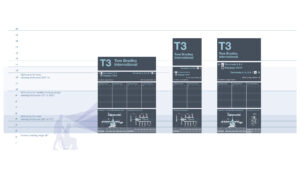
Lastly, user-centered experience design integrates all these practices together with a focus on designing, choreographing and testing inclusive and effective visual, verbal and virtual communication systems to provide continuity of support for a diverse range of users.
In terms of airports, effective wayfinding relies on carefully stitching the built environment with known and anticipated human behaviors to achieve desired outcomes for today and in the future. Layer onto this the complexities of serving millions of domestic and international airport guests annually and the demand to get them where they need to go in the most efficient and stress-free manner possible. Something that is not a science per se but works alongside technical pursuits is finding chances to layer in unexpected delight and joy through art or other means.
Can you talk us through LAX’s new approach to wayfinding and what solutions are involved (digital versus physical signage, rebranding, etc.)?
Our approach to the new, holistic wayfinding program relies on legibility and intuitive design, as well as resilient and maintainable systems. New implementation guidelines will ensure a cohesive experience across the entire airport campus and will inform diverse touchpoints such as the forthcoming APM train system, roadways, parking facilities, curbs, terminals, concessions and gates. Again, it is not just about physical signage – digital experiences and human interactions will also be shaped by the project’s guidelines.
A key aspect of LAX’s enhanced wayfinding system is the development of a new mapping suite, comprising a new range of maps and plans that can be used everywhere consistently and at different scales in analog and digital media and applications. As static media, they will be orientated into a “heads-up” – facing the direction users are moving – to aid easy and intuitive orientation. Each map will show just the right amount of geographic area and information to support the next step in the journey, so people are not overloaded with unnecessary information to interpret and learn as they move between different scales of the environment.
How are you effectively managing your digital wayfinding content?
Currently, digital content at LAX is managed through various systems. For example, the digital displays at Tom Bradley International Terminal, such as the flight information display system, airline name display system, digital art system and visual paging system, are managed by different, unconnected systems.
LAWA is in the process of developing a campus-wide digital content management system (DCMS) that will enhance the guest journey by providing a unified, integrated digital content management platform for all of the airport’s digital displays and digital passenger interfaces.
“The DCMS will serve as the ‘single source of truth’ when delivering critical operational and emergency messaging to guests and staff”
The DCMS will serve as the ‘single source of truth’ when delivering critical operational and emergency messaging to guests and staff. This system will have the ability to rapidly provide up-to-date information and will enable LAWA to instantly respond to the wide variety of operational changes that occur at our large and dynamic hub where seamless integration of multiple services is critical to ensuring positive guest experiences.
The overall digital content management architecture and ecosystem will be supported by a single DCMS platform that will be integrated with a wide spectrum of data sources to deliver the appropriate level of content to each display. It will provide consistent and clear wayfinding information through digital media and will lower operational overheads through system efficiency and integration consolidation.
The DCMS software will store and manage the distribution of all content to all digital screens campus-wide aligning with the existing static signage. The new DCMS platform presents the perfect opportunity to refresh the ‘look and feel’ of content and branding standards. This will result in consistent information, hierarchy, identity and nomenclature that will be applied to a range of templates. These templates will be stored and used by each digital screen type, responding to location-specific user needs and real-time changes in operations.
What stage is the wayfinding project at?
We are in between the project’s programming and early design stage and the multi-phase design and construction rollout. This year, we will engage a progressive design-builder firm that we will collaborate with further on the design and phasing strategy. Once a prioritization plan is in place, the firm will implement the work, targeting completion before the Olympic and Paralympic Games.
How did you work with other airport stakeholders to ensure a consistent approach to wayfinding? Is the same wayfinding approach used across all LAX terminals and within supporting facilities, such as the APM and car rental facility?
Wayfinding is the most looked-at part of the airport and can have one of the biggest impacts on the guest experience. In addition to standardizing the wayfinding system, we will be implementing a campus-wide revised gate numbering system that will impact every airport environment and system (airfield, airside, landside, roadways, parking garages, APM train and more). Engaging with stakeholders and our partners throughout the process is critical to the success of the program – working collaboratively and maintaining meaningful and open communication with stakeholders and our partners is vital to transforming the LAX guest experience.
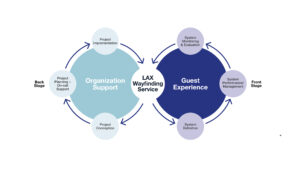
When LAWA undertook the wayfinding study in 2018, there was a comprehensive stakeholder process, including operational and management teams, the LAMP team and the Capital Improvement Program teams. In these stakeholder group sessions, we learned of specific wayfinding challenges. For consistency and transparency, larger sessions were held with all stakeholders to hear the wayfinding strategies. Their comments and feedback were then incorporated into the wayfinding standards.
Throughout the lifecycle of the project, we will be engaging with stakeholders and our partners to align on expectations; resolve design, technical and operational issues; and make sure their comments and concerns are heard. The LAWA and the design-builder wayfinding project team will work closely together to facilitate the stakeholder engagement process, informing partners of the implementation plan, strategies and approaches, and requests for input, incorporating their feedback into the design, construction, activation procedures and training manuals.
What lessons have you learned during this project, and what advice would you give to other airports looking to overhaul their wayfinding system?
Wayfinding is not just about signs … It is not a traditional project. We are not building a building. We are building a system that will influence guest behavior, including how guests arrive at the airport, what they do when they are there and how much they spend. A holistic approach to wayfinding can make a real difference in guest perceptions and emotions.
Careful and thoughtful planning, and bringing our stakeholders and partners along on the journey, are paramount to an exceptional project outcome. We cannot be working in silos because wayfinding touches every part of the airport. There are interdependencies and the sooner we understand and learn them, the system will perform the way it should.
There are so many construction activities going on at LAX that alter passenger flows from time to time. We have learned that signs alone do not address the challenges of maintaining efficient routing and intuitive journeys. Guest experience needs to be considered throughout the planning, design and implementation phases. Too many signs can cause confusion, which can leave guests feeling anxious, so we embrace the ‘less is more’ mantra.
Last year, we conducted a gap analysis of the LAX wayfinding standards. We identified that the naming conventions for gate renumbering would result in a highly complex information system that would add unnecessary stress to our guests’ journeys. We recommended an approach to renumbering the gates without engaging the stakeholders in the process. When we made our recommendation, we received pushback initially, so we changed our approach to obtaining stakeholders’ concurrence by engaging the stakeholders, staff, airlines and passengers in a user testing exercise.
“Participants were also confident they were going the right way using the alpha-numeric gate approach”
We presented two gate renumbering scenarios: number series (100s, 200s, 300s); and the alpha-numeric (A1, B1, C1). The goal was to collect qualitative and quantitative data on navigational ease for each scenario. Participants were given a brief introduction for each scenario and were asked to locate their gates using sample boarding passes. No mention of gates or terminals was made when introducing the process. The outcome was that all could use both numbers and alpha-numeric systems and that the participants favored the alpha-numeric approach because it was easy and fast to navigate. Participants were also confident they were going the right way using the alpha-numeric gate approach. The alpha-numeric gate strategy leads to more efficient directional information planning, and a reduction of failed journeys and unnecessary back-tracking and time spent lost, while increasing discretionary time.
Following this work, we received concurrence from stakeholders on our recommendation. Involving the stakeholders in the process helps them understand the methodology, approach and strategy. Evidence, mock-ups and 3D renderings can be a powerful tool in gaining approval when implementing a holistic wayfinding system, too.
Is physical signage more effective than digital?
The most effective wayfinding strategy involves a mix of physical and digital signage to respond to specific challenges of an airport and its structured environment, as well as the diverse needs, capabilities and preferences of its passengers.
Physical and digital signs support people’s needs in different but complementary ways – one medium supports persistent information; the other supports dynamic information. They are different mediums with different affordances and constraints. These are choreographed in response to needs that arise at different points in a passenger’s journey – across departures, arrivals and connecting pathways. Both have different ongoing maintenance patterns and costs. In the case of technology failures or power outages, physical signage serves as a reliable backup. A well-balanced wayfinding strategy usually involves a combination of both physical and digital elements.
Physical signs are tangible and straightforward and provide a clear and immediate visual reference for passengers without relying on technology. Their simplicity can be especially effective in guiding people through basic wayfinding tasks. Physical signs and wayfinding products integrate with reality while setting the stage and providing persistent information and storytelling contexts. Physical signage presents a consistent visual identity and accessible design language throughout environments. Their consistency in design and placement contributes to a more cohesive and easily navigable environment by creating continuity. Universally understandable icons, symbols and colors on physical signs can convey information without relying on text, transcending language barriers. Physical signs are also durable and can withstand environmental factors such as temperature variations, humidity and physical wear and tear. This durability is crucial in high-traffic areas like airports.
Digital signage enables quick changes to content without physically replacing signs and this adaptability is valuable in dynamic environments where information may change frequently. This display flexibility is particularly useful in conveying time-sensitive information such as gate changes or flight updates. Interactive digital signage, such as touchscreens or kiosks, enables passengers to engage with detailed information, personalized assistance or additional services, but are constrained by one-on-one use cases. Digital displays can showcase multimedia content, animations or videos and can enhance the overall aesthetic experience. Depending on programming, digital signage can convey a large amount of information in a smaller physical space compared to an equivalent number of traditional signs. This can be particularly beneficial in areas with limited wall or floor space, but this requires an in-depth understanding of people’s situated needs in that setting.
LAWA will continue to conduct usability studies and gather feedback from passengers to help identify specific challenges and areas for improvements in LAX’s wayfinding system. Iterative testing with all types of information interfaces with representative user groups helps refine proposed designs. Ultimately, it is not that one medium is necessarily more effective or important than another – both types of signs have their advantages and disadvantages. This type of analysis can be further extended toward, for example, mobile app technologies and guest services.
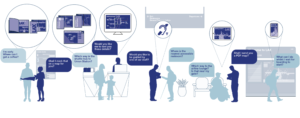
During your work at LAX, have you identified any new key trends emerging when it comes to wayfinding?
Wayfinding is critical to the smooth operation of the airport and the experience of its guests. With our wayfinding program, there are opportunities to design a system that is innovative, inclusive, accessible and equitable for all guests.
Infrastructure and facility improvements alone will not guarantee an iconic guest experience. The layout of spaces and arrangement of elements – such as lighting, surfaces, furniture, art, advertisements, help desks, signs and displays – and the correct combination of these experiential touchpoints in each environment and journey stage save guests time and reduce stress.
Personalized information through digital applications provides real-time location and enables guests to tailor information to their needs and preferences. By blending technology and physical signs through digital displays and kiosks, guests can obtain real-time information on queues at security checkpoints, routing information and walk-time. This helps passengers navigate the airport with ease and confidence and enables them to make the best use of their time.
Currently at LAX, the use of pictograms and graphic styles to illustrate messaging varies. To create visual harmony and establish a confident wayfinding system, pictograms will be revised so that they feel a part of a set, with a consistent look and feel. Greater use of pictograms will be accessible to all guests, especially first-time visitors, those with different abilities and non-English speakers.
Creating a seamless positive experience for guests requires the right combinations of product and information types exactly where they are needed, at the right size and in the right format. Consistency across the system is achieved through rigorous information planning.
How have you ensured the wayfinding system is futureproofed at LAX?
Simply put, it is important to anticipate and respond to people’s current and future needs. In practice, this could relate to the identification of evolving behavioral trends and the identification of technological advances which would further enhance the delivery of information.
The wayfinding system is designed to be flexible in an ever-changing airport and world. Our approach and strategies are adaptable to accommodate many Capital Improvement Program projects that are in the planning and design phase, as well as future developments, enabling us to support project efficiencies and synergies to maximize value impact.
Key to our approach at LAX is the use of universal design strategies that ensure wayfinding systems are anchored in a general understanding of human capabilities and limitations. This is where practices such as ergonomics and human-factors engineering provide knowledge and play a key role in setting standards around wayfinding systems, constraints and performance criteria.
It is also important to tailor wayfinding systems around the specific needs and goals of airport guests, in line with the clear set of guiding principles the project aims to achieve. For this, we use robust discovery practices as part of the overall design process to ensure we are designing for the airport today and in the future through further infrastructure developments and new digital technologies.
A primary example of futureproofing is our recent efforts to define a new LAX Nomenclature Strategy that includes terminal and gate renumbering. As part of this effort, we identified that LAX is outgrowing its existing naming conventions, and as a result, guests are presented with highly complex directional information that is confusing and unintuitive. This has hindered guests’ ability to instantly understand the sequencing of spaces which leads to a lack of clear understanding of time and distance between destinations. We have therefore undertaken extensive studies, including best practice reviews and user testing with executives, airport staff, airlines and passengers, to ensure we are implementing the most intuitive and logical approach that considers the many years of expansion to come.
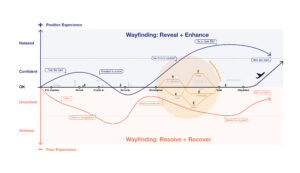
What are some of the key benefits for airports when it comes to improving wayfinding?
The benefits of improved wayfinding in airports extend beyond the immediate positive impacts on passenger flow. These encompass enhanced passenger experiences, direct revenue generation, accessibility, brand image, competitiveness and data-driven operational efficiencies.
Quality wayfinding reduces the passenger stress and anxiety associated with navigating unfamiliar environments. This contributes to an overall positive passenger experience, fostering satisfaction and loyalty. Efficient wayfinding leads to more relaxed travel experiences by helping passengers reach their destinations more quickly, reducing the wasted time spent on searching for gates, services and amenities. This saving of time increases guest satisfaction and provides a context for increased direct revenue generation.
Clear and effective wayfinding can direct passengers through commercial areas, promoting exposure to retail outlets and amenities. This can lead to increased spending on shopping, dining and other services within the airport. Effective wayfinding highlights and promotes the various service offerings, including lounges, duty-free shops and premium amenities, encouraging passengers to explore and use these facilities. The universal design of wayfinding systems benefits passengers with diverse needs, including those with disabilities or specific requirements, ensuring that navigation systems are accessible to everyone and promoting inclusivity.
An airport with effective wayfinding systems is likely to be perceived as well-managed and passenger friendly. This positive perception contributes to the overall brand image and reputation of the airport. In turn, airports that invest in superior wayfinding can gain a competitive advantage, attracting more airlines, passengers and business partners due to their commitment to a seamless travel experience.
While better wayfinding does make for smoother passenger flows, reduced congestion also has knock-on effects for optimizing the overall operational efficiency and this can result in more efficient uses of airport resources and quicker turnaround times for aircraft.
These benefits are anchored in data-driven insights – digital wayfinding technologies can collect data on passenger movements and behaviors that can be analyzed to gain insights into passenger preferences, traffic patterns and areas where improvements are needed. With a better understanding of passenger movements, resource allocation such as staffing levels at security checkpoints can be optimized based on real-time data and passenger flows.
Patterns in data collected over time can be used to inspire ongoing improvements in wayfinding systems, adapting to changes in passengers’ behaviors and preferences.
Is there anything else you would like to add?
The multibillion-dollar transformation underway at LAX will touch all terminals in addition to adding millions of square feet in new facilities and infrastructure. Not implementing a new wayfinding program at the airport during this critical moment would be a noticeable misstep. When this project is complete, our terminals, gates, baggage claims, APM train stations and ConRAC facility, in addition to other components, will be easy to navigate and, for the first time ever, understood as interconnected, with each element logically corresponding to the next. I am proud of the work being performed by our internal staff, airport partners and stakeholders and look forward to our continued shared effort with our future design-build collaborator.
For more top insights into LAWA’s wayfinding program, read Passenger Terminal World’s exclusive wayfinding feature here.

